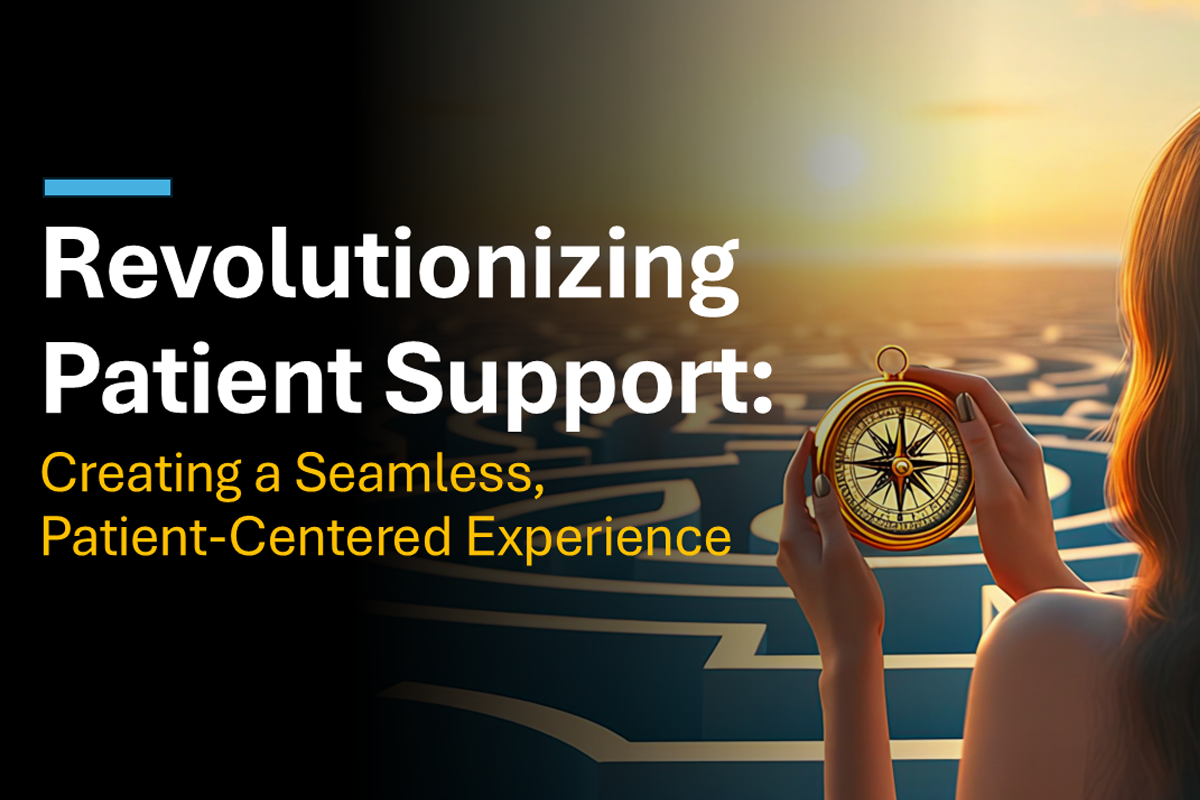Revolutionizing Patient Support: Creating a Seamless, Patient-Centered Experience

For manufacturers looking to improve outcomes, ensure operational excellence, and deliver lasting value to customers, building a coordinated access model is no longer just a difference – it’s a competitive necessity.
Revolutionizing Patient Support: Creating a Seamless, Patient-Centered Experience
Introduction
Delivering on the promise of innovative therapies requires more than removing roadblocks. It demands a thoughtfully designed, well-aligned model that connects product delivery, affordability, and customer engagement across every touchpoint. In today’s healthcare environment, therapies are more complex, stakeholder expectations are evolving, and the urgency to get things right has never been greater.
For manufacturers looking to improve outcomes, ensure operational excellence, and deliver lasting value to customers, building a coordinated access model is no longer just a difference – it’s a competitive necessity.
In the final installment of our blog series, we share real-world insights and case studies showing how pharmaceutical manufacturers can address persistent challenges and build access strategies that deliver measurable results. When distribution, dispensing, and customer-first support align, programs remove barriers and create clarity, consistency, and momentum for all stakeholders.
Distribution: Ensuring Medication Availability & Delivery
Seamless access begins with availability. Even the most well-designed programs can’t function without the right distribution strategy. Distribution challenges often remain suppressed until launch, but delays in site onboarding, credit restrictions, or cold chain issues can stall therapy initiation before it starts.
To prevent friction, distribution strategies must be aligned with patient preparation, provider readiness, and supply chain capacity. The following actions are essential:
- Verifying licensure and onboarding sites pre-launch to avoid 72-hour delays common with new customer setups, including credit checks, ERP configuration, and invoicing.
- Providing real-time inventory visibility between distributors, providers, and support teams to prevent ordering disruptions and improve coordination
- Selecting the right distribution model (i.e., stocking, drop-ship, direct-to-patient, etc.) based on product profile, therapy type, patient volume, and logistical requirements
- Accounting for cold chain requirements early, particularly for cold chain therapies and other ultra-low temperature therapies with limited shipping and storage windows
Complicating matters further are credit limits, product damage risks, serialization exceptions, and weekend service restrictions, all of which can add hours or days to the timeline between prescription and product receipt.
Case Study: Realigning Distribution to Expand Access and Reduce Risk
A pharma manufacturer launched a specialty therapy through an exclusive drop-ship model via their 3PL, expecting tight control over distribution. However, real-work access challenges emerged:
- Community-based infusion sites were denied ordering privileges due to credit thresholds
- Sites weren’t onboarded into ERP systems in time, delaying fulfillment by days
- There were no emergency ordering capabilities over weekends, preventing timely treatment starts
- The serialized product was repeatedly held in quarantine, not due to transmission issues but due to the manufacturer’s lack of exception-handling protocols and SOPs. The product was flagged, and partners lacked direction on release, causing unnecessary stockouts.
Archbow partnered with the manufacturer to evaluate the distribution design and execute an optimization strategy to:
- Expand the network to include accessible regional sites with alternative credit terms
- Implement pre-launch onboarding workflows to reduce setup lags
- Create serialization exception SOPs, clarifying roles, timelines, and resolution paths to prevent quarantine-related product holds
Result: A significant improvement in time-to-therapy and a measurable decrease in complaints from sites of care and field teams – driven by broader access, faster onboarding, greater product availability, and reduced delays tied to credit, ordering, and serialization issues.
Specialty Pharmacy: Managing Dispensing Challenges & Supporting Adherence
Once a product is available, dispensing becomes the next critical gear in the access model. Specialty pharmacies sit at the center of benefit approvals, affordability programs, and patient education – yet many patients still face confusion, delay, or abandonment.
To improve outcomes, specialty pharmacies must:
- Integrate benefit verification and ePA processes into workflows to reduce provider burden and accelerate approvals
- Use data to flag patients at risk of drop-off due to stalled paperwork, missed outreach, or lack of Prior Authorization (PA) progress
- Connect proactively with support teams and affordability platforms to support patients earlier in their journey
- Tailor engagement for patients managing various obstacles, including side effects, refrigeration, self-administration, or emotional fatigue
Case Study: Coordinated Intervention Improves Adherence and First Fill
A specialty therapy brand noticed early abandonment after prescription. Too many patients were approved but never initiated therapy.
Archbow worked with the specialty pharmacy and Patient Support Program (PSP) to:
- Use data signals, like failed call attempts or PA processing lags, to identify patients at risk
- Trigger personalized outreach, including clinical education calls, text reminders, and affordability coaching
- Integrate financial assistance earlier in the onboarding process, ensuring eligible patients don’t fall off due to cost before they even started
Result: A significant increase in adherence and a measurable reduction in first-fill abandonment, particularly among patients who had previously stalled during onboarding.
Customer First Support: Centered on Real People, Built for Real Complexity
Patient Support Programs are often the most visible part of the experience and the most personal. When PSP services are reactive, confusing, or disconnected, they can erode trust and reduce engagement.
Patients, caregivers, and providers benefit from intuitive, empathetic, proactive support. PSPs should:
- Offer simple, low-friction ways to help (not just 8 am-8 pm call centers with Interactive Voice Response)
- Anticipate needs before patients reach out, using behavioral triggers and engagement data
- Provide coordinated touchpoints across nursing support, affordability measures, and access navigation
Case Study: Transforming the Experience Through Simplicity and Empathy
In a rare disease therapy program, patients were dropping off medication due to long hold times, missed follow-ups, and inconsistent communication across partners.
Archbow partnered with the manufacturer to redesign the support model around the needs of real people – patients, providers, and Field Reimbursement Managers. Archbow supported the following:
- Replaced complex phone trees with direct access to live support
- Added after-hours digital chat for quick questions and support
- Aligned workflows between the specialty pharmacy and the patient support program
- Trained patient care specialists in empathy, tone, and support best practices
- Educated nurse navigators on reimbursement best practices to support the full access picture
Result: A measurable increase in patient and provider satisfaction, improved collaboration between specialty pharmacy and patient support program (HUB) services, and fewer therapy disruptions.
Stakeholder Alignment: Supporting the System
Payers, providers, and partners aren’t separate components; they’re embedded across every gear in the system. Programs that succeed:
- Build payer-aware workflows into enrollment and access
- Monitor changing coverage policies that affect therapy availability
- Implement a design around how providers actually operate, not just how we wish they did
When these stakeholders are accounted for early, the experience becomes more predictable, consistent, and scalable.
Conclusion: From Complexity to Clarity
As therapies become more complex and customer expectations rise, delivering a seamless access experience is a competitive necessity. Integrating distribution, dispensing, and support services into a unified system helps manufacturers reduce delays, improve experiences, and differentiate their offerings in a crowded landscape.
At Archbow Consulting, we help our clients build and operate access models that span the entire treatment access journey, from distribution to dispensing to customer-first support. We understand how these functions connect, where friction points emerge, and how to align them into one cohesive system.
As we prepare to take the stage at Asembia, we aim to prepare our readers with real-world expertise, cross-functional insights, and a focused vision for developing access strategies that break down barriers and enhance the overall customer experience.
Tell us: What part of your treatment access model needs to work more efficiently? Let’s build the next phase of success together.
1Sources:
Medication non-adherence: a common and costly problem – PAN Foundation
For additional insights on this topic, you may also enjoy the following:
Navigating the Complex World of Pharmaceutical Returns Processing
Efficiently managing product returns is a critical lever for controlling costs, minimizing operational inefficiencies, and reducing end-to-end complexity.
What Happens in Vegas… Ends Up in Our Blog: Asembia 2025 Edition
Asembia 2025 clarified that the pharma landscape is rapidly evolving, with innovation and partnership as the driving forces.
Understanding Fair Market Value
Why It Matters and How Archbow Consulting Can Help You Navigate It
SUBSCRIBE
Subscribe to receive news and updates from Archbow Consulting
|
|


